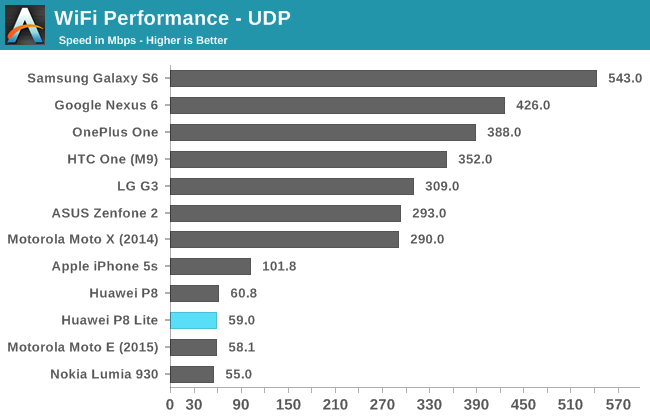The Huawei P8 Lite Review
by Brandon Chester on July 27, 2015 8:00 AM EST- Posted in
- Smartphones
- Huawei
- Mobile
Camera
Since the Huawei P8 Lite is positioned as a mid range device rather than a low end one, it brings along significant improvements to the camera system when compared with devices in the sub-$200 range. The basic specs on paper show a rear-facing camera with a 13MP resolution, and a front-facing camera with a 5MP resolution. Both these sensors are made by OmniVision, and you can see some further information about the P8 Lite's cameras in the chart below.
| Camera Specifications | |||
| Huawei P8 Lite | |||
| Front Camera | 5MP (2592x1944) |
||
| Front Camera - Sensor | OV5648 (1.4 µm, 1/4") |
||
| Front Camera - Focal Length | 2.4mm (22mm eff) | ||
| Front Camera - Max Aperture | F/2.4 | ||
| Rear Camera | 13.0MP (4208x3120) |
||
| Rear Camera - Sensor | OV13850 (1.12 µm, 1/3.06") |
||
| Rear Camera - Focal Length | 3.8mm (27mm eff) | ||
| Rear Camera - Max Aperture | F/2.0 | ||
The Huawei P8 Lite buys you a lot of camera for a $250 smartphone. With a 13MP resolution and a 1/3.06" sensor size, the P8 Lite's rear camera is in the same league as phones like the Nexus 6. The F/2 aperture is also quite large, and from my testing Huawei appears to have kept distortion under control while reaping the benefits of the additional light collected with the wider aperture.
It seems that OmniVision gets a bad reputation in the mobile space. However, I think the P8 Lite is a testament to how much of a difference good photo processing can make, and how many of the perceived issues with OmniVision sensors are really just the result of poor ISPs (image signal processor) and image processing. As far as image quality goes, I have absolutely no major complaints about the P8 Lite's rear camera when taking photos during the day. There's good detail preservation and sharpness, without the harsh shadows and over sharpening that I often see with cameras on less expensive devices. My only complaint is that the P8 Lite skewed the white balance of this scene toward blue, which made all of the colors seem colder than they actually were. Despite this, the color saturation, sharpness, and detail are all great for a $249 device.
In low light the P8 Lite seems to stumble a bit. This doesn't appear to be any fault of the sensor, although a 13MP camera with 1.1 micron pixels won't exactly be a master of low light photography. Rather, it's clear that Huawei's heavy noise reduction is having a negative impact on image quality. The entire photo is fairly devoid of detail, and has an appearance that looks somewhat like an oil painting. This has done a great job of removing the noise in the photo, even in the sky, but it has also smeared away all of the detail. It's clear from the exposure and white balance that you could actually take some decent low light photos with the P8 Lite if the noise reduction wasn't so heavy, and I hope Huawei can address that in the future.
Overall I'm fairly happy with the P8 Lite's photo quality considering its $249 price. It's definitely the best camera I've seen at this price point due to its well balanced processing during the day. Noise reduction in low light definitely needs to be toned down, but even then the photos end up being better than many other low or mid range devices simply due to the more accurate exposure.
Video Quality
While still images are the product of both the camera sensor's quality and the quality of the processing performed by the ISP, videos skew even more heavily toward the abilities of the ISP as there needs to be a sufficient level of processing done to each frame in a timespan measured in milliseconds. The P8 Lite uses the ISP built into Qualcomm's Snapdragon 615 SoC. While ISPs are still pretty much black boxes, Qualcomm has noted in the past that the feature set for S615's ISP is more closely related to the ISP in the Snapdragon 800 series SoCs than the Snapdragon 400 SoCs.
The Huawei P8 Lite has a maximum video resolution of 1920x1080, and it records at 30 frames per second. Video is encoded at 20Mbps using the H.264 baseline profile. Unfortunately, the video quality of the Huawei P8 just isn't near as good as still images in the same lighting, highlighting either some limitation of the ISP or an issue with what processing is being applied. There's a general blurriness across the frame, with very little detail on the grass or the sidewalk. The camera's focus locks at the beginning of the video which means turning to look at a different area for a moment is often out of focus, and this is made very evident when turning to look at the red bushes. There's also some sort of issue with the audio where the right channel starts and stops working as it pleases. While the daytime image quality of the P8 Lite is very good, the video quality is definitely not something I would consider to be a selling point.
WiFi Performance
802.11ac adoption isn't that widespread yet, and buyers of devices like the P8 Lite are unlikely to have 802.11ac routers unless it's built into the modem provided by their ISP. Despite that, devices like the ASUS Zenfone 2 have spoiled us a bit by delivering 802.11ac support in a $200 device. The Zenfone 2 is often an exception to the rule though, and the P8 Lite only ships with support for 802.11n on the 2.4GHz band.

With a peak speed over UDP of 59Mbps, the P8 Lite falls in line with the other 802.11n devices on the chart. Since the P8 Lite costs $250 and is positioned as a mid range device I'm disappointed that there's no support for 5GHz networks, as it leaves users on the increasingly crowded 2.4GHz band. Even so, I doubt that buyers of the P8 Lite will be doing anything that requires faster speeds than 802.11n provides.
























45 Comments
View All Comments
joeroyhud - Monday, July 27, 2015 - link
The P8 Lite supports LTE band 12, which makes it attractive if you're a T-Mobile customer like I am. I got the phone on sale a couple months ago for $200. I like the size and the performance and the battery life, but it's overpriced at $250.Glock24 - Monday, July 27, 2015 - link
This phone seems like a bad choice. Glad I got a ZenFone 2, but sure since I got the 4GB RAM/64GB flash version it cost me $300. Battery life on ZF2 is not great, but has improved a bit with system updates. I guess if the P8 Lite had Android 5.0 it would have even worse battery life.austinsguitar - Monday, July 27, 2015 - link
g4 pleaseedwd2 - Monday, July 27, 2015 - link
SD615 is a plain no for me. It's arguably worse than the SD600 and the MT6752 smokes it in every aspect at a lower price point.Speedfriend - Tuesday, July 28, 2015 - link
"As for performance, Snapdragon 615 is really the best you're going to get at this price point unless you go with the Zenfone 2 which is something of an anomaly in many ways. "Which begs the question why more manufacturers aren't using Intel chips which clearly smash the performance of any other mid range priced offerings?
Stick an Intel chip in a Moto G and I'll buy that!
LiverpoolFC5903 - Tuesday, July 28, 2015 - link
Agree, I dont understand why more manufacturers do not use the newer Silvermont based Intel chips, considering the performance levels and the low price. Much better than using mediocre socs like Snapdragon 410/615 at similar price points. Having used the ZF2, I can personally attest to its performance in handling anything Android has to offer.Buk Lau - Wednesday, July 29, 2015 - link
The answer is simple, Intel chips don't come with integrated modems. just look at zenfone 2, that thing comes with XMM 7262 with CAT 6 LTE disabled, and if this doesn't show you the problem already, Qualcomm's Gobi modem even comes with integrated GPS solution whereas Asus has to include a Broadcom solution. so just by using these atoms you already have to include 2 other chips whereas Qualcomm just gives you an all-in-one solution. then the choice is obvious, unless intel is literally paying money to you, which they did, what incentive is there for you to use their more complicated solution instead of qualcomm's? and this is how qualcomm got to become what it is today. back in the old days qualcomm's SoCs suffered even worse overheating and performance and yet OEMs still persist to use their stuff, simply because they offered an integrated modem. in a sense, OEMs only have themselves to blame rather than qualcomm for having to release junk phones all over this year, if they didn't spoil qualcomm so much back then, there wouldn't be so little choices in the SoC marketBadelhas - Tuesday, July 28, 2015 - link
The European / Asian version has Lollipop UI Emotion 3.1 and the their own HiSilicon's Kirin 620 SoC. Is it possible to review that one? Seems much better than the American version...A friend of mine bought one and it´s pretty slick, even if I continue to prefer the Moto E, considering the price.
PrinceGaz - Tuesday, July 28, 2015 - link
eww, you've got really hairy arms! (just joking, there were complaints in the comments about the iWatch that the guy wearing it had hairless arms :)So why would I want a phone with eight A53 CPUs? In my experience with a quad-core tablet, it rarely uses more than two of them fully when it is running at full speed, with the third and fourth cores doing a bit of work but hardly ever even approaching fully utilised (probably just running the tasks that need to be run anyway, so their main purpose is taking a tiny bit of work off the other cores).
Given that a 64-bit CPU is a bit unnecessary when phones have yet to reach 4GB RAM, and probably counter-productive power-wise as a result (just look at A15/A7 vs A57/A53), whilst benchmarks may run faster on a quad-core 1.5GHz A53, I suspect I'm better off with my old dual-core 1.7GHz Krait for most daily usage. It lasts me all day and never feels slow, and most of the time (according to a CPU usage monitor) one of the cores isn't being used much. I don't play 3D games much on my phone; so I never tax the GPU, therefore the Adreno 305 is perfectly fine for me,
What workload other than benchmarks requires more than two CPU cores? The main one that occurs to me is a browser, in which case you would be much better off culling battery draining processes rather than running them.
Ethos Evoss - Saturday, August 1, 2015 - link
pls honor 7 reviewthnx